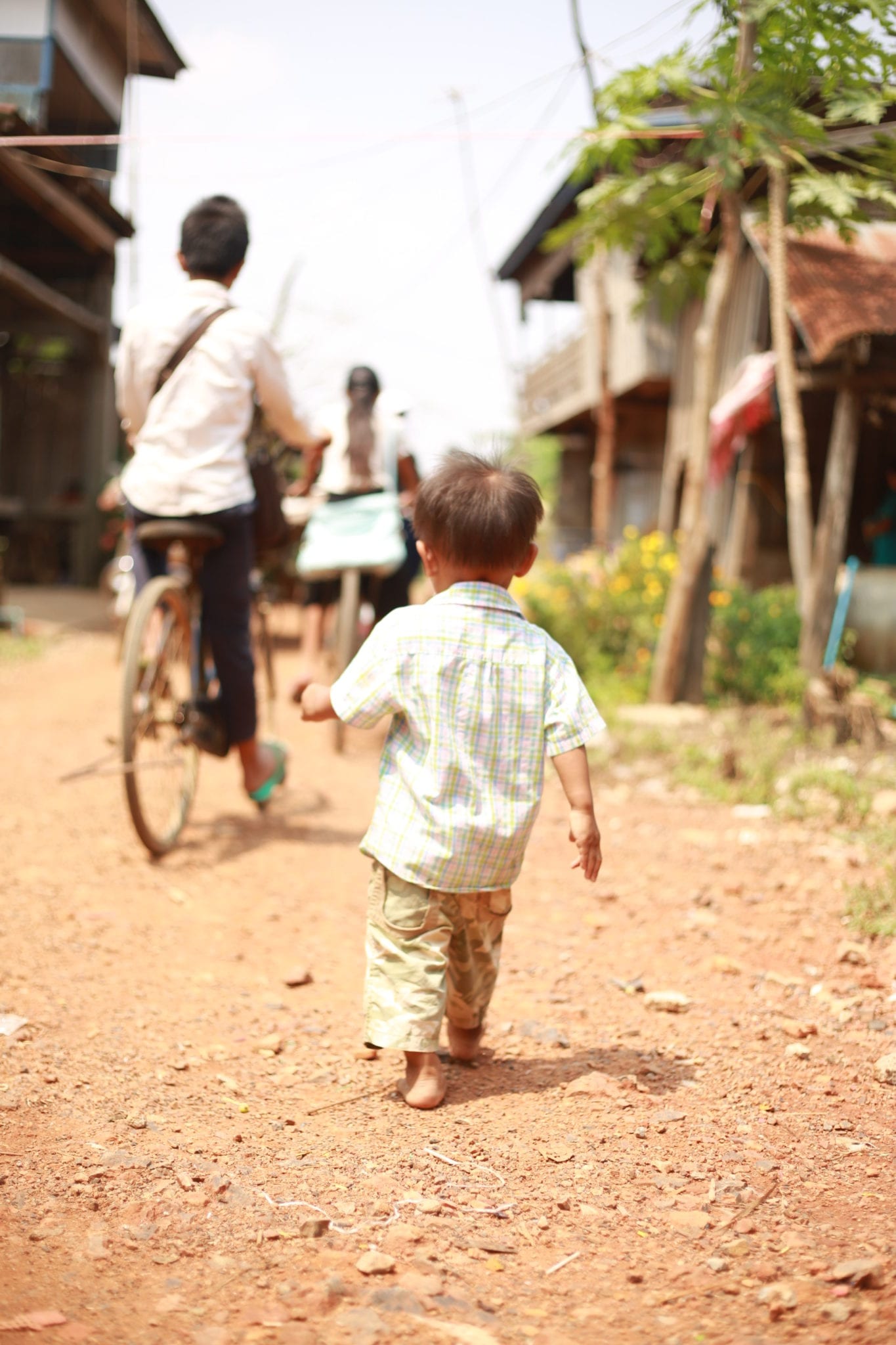Battambang. Looks easy to figure out how to say it, right? Wrong. Actually pronounced “Bat-nam-bong”, this charming little town is a wonderful mix of French colonial architecture and classic Cambodian buildings.
Our route from Sihanoukville to Battambang wasn’t going to be a particularly complicated one: get on one night bus, sleep in the moderately comfortable 30 degree angled seats until Phnom Penh, where we get on another bus, revel in the good fortune of getting the flat mat at the back and sleep remarkably well until we wake up in….. Wait, where are we?
Cambodian bus drivers don’t actually announce when you’ve reached a stop, although they do turn lights on sometimes. However, sleeper buses have two rows of seat-cum-beds stacked on top of each other and, when you’re on the bottom, you might as well be in a cave. There’s a moment of slight panic when we realise that we can’t feel the bus moving, so Rich rushes to the front to find out where we were. Battambang. With the bags all having been unpacked, repacked and the bus full of passengers ready for the next trip. Crap! We grab our stuff, hustle around the side of the bus and, much to the guy’s frustration, get the baggage man to find our bags in the disorganised mess of luggage. Given that mine is the colour of a butternut squash, this turns out to be quite a simple task, but the poor guy didn’t know what was coming next.
Another girl, equally confused, gets off the bus just after we do. She’s asking questions and it quickly becomes apparent that she’s deaf. She needs to know where we are and there’s some general confusion about Bangkok. I quickly grab a pen and paper, write “Bangkok” and point at the bus, figuring this indicates that the bus is going to Bangkok. I wrote “Battambang” with an arrow, indicating that’s where we’ve stopped. She begins a frantic search for her bag, when it becomes apparent that she is French – and doesn’t speak English. Several minutes later, she finds her bag and then turns to us and mouths “Bangkok?”, gesturing as though to ask where she needs to go to get her next bus. You’re kidding, right? We reiterate that THIS is the Bangkok bus, get the filthiest look from her, then watch as she re-stows her bag and boards the bus. Feeling like this was somehow all our fault, we apologise to the baggage guy and go across the street to collect our wits and get over the incredibly rude response to our efforts to help. It is 6am. What a start to the day.
We’d chosen a guesthouse not far from the bus stop, so we walk the five minutes it takes for us to find it. Along the way, we are intercepted by a tuk tuk driver who wants to know where we’re from, what we’re doing today and where we’re going (standard). We tell him we have no plans and the name of our guesthouse and he points us in the correct direction without asking us if we want a ride (not standard; refreshing). And so we come to be acquainted with Han, my new favourite Cambodian.
Later that morning, after we stow our bags in our $3 room at the oddly-named Tomato Guesthouse (where the sink drains onto the floor and the bathroom is so small that you do, indeed, need to stand at the toilet to shower – see my “Open Letter” post for more on my thoughts about whether or not this is a problem) and I have an exceptionally-less-than-mediocre coffee and cinnamon bun (DEFINITELY not something to write home about, in spite of my original excitement upon seeing it on the menu), Han collects us from out front and we set off on a day of adventure. First stop: the post office. Okay, not part of Han’s adventure, but we wanted to find out how much it would cost us to mail 3.5kgs of goodies home. Sixty-seven DOLLARS?! Okay, we can just carry it in our packs for another six weeks, thank you.
Right. Adventure. So Han takes us to a statue of a man with a big black moustache and a big black stick. Turns out, there’s a legend about this Cambodian Aladdin and the town is named after him. Han clearly loves telling us the story about how the man fed and protected the town, his eyes growing wide as he gesticulates and laughs his way through the tale in his remarkably-good-but-heavily-accented English. We set out again, heading down increasingly rural routes, until we end up down a laneway, which suggests we have reached our next stop: the bamboo train.
Before I left home, I had been watching some travel shows, one of which showed a woman who went backpacking in Cambodia and hopped on the bamboo train instead of the bus for one of her location changes. I was immediately enamoured with what I saw: not so much a train as a motorised cart, these 6’x5′ platforms rest on two axles that have miniature train wheels; the motor at the back looks (and sounds) similar to what would’ve been found under the hood of Dad’s first riding lawnmower. When a “train” travels down the track, which is no longer used by real trains, and encounters an obstacle (ie another “train”), all passengers and their cargo are offloaded, the train is disassembled and removed from the tracks, the other train rolls past, and the disassembled train is reassembled so it can head back on its merry way. Ridiculous and incredible all at the same time.
Since seeing that clip, I had learned that the bamboo trains no longer operate as a mode of transport, but they do still run for tourists. When we arrive, we pay our $5 each and then stand back and watch the goings-on so that we understand how everything works. Our turn to board comes, so we hop on and spend 20 bone-jarring minutes marvelling at the ingenuity of it all – and the fact that ANYTHING could manage to stay on tracks that have such terrible joins. We meet another train and watch, smiling, as the occupants go through the disembark/disassemble/reassemble routine, while we use our feet to roll our train past them (our driver shut off his engine when he went to help). We meet cows, cross questionably stable bridges, watch water buffalo and generally have a lovely trip. When we reach the little village that marks the “end of the line”, we get off and are given a tour by five very excited children. It is only after the little scheisters demand money for the tour that we realise why they’d been so eager in the first place. Oh well… Our tour takes us through the very small village and we delight in chatting with the children and watching the residents get on with daily life. Other than a particularly cantankerous three-ish year old who has absolutely zero interest in being anywhere near me, my favourite sight is an infant who, from his position in a plastic washtub on the front porch next to the home’s giant water urn, keenly follows my progress down the road. We walk past the derelict, burnt-out remains of a former Khmer Rouge base, sitting abandoned down one short little road. After the war, the villagers had clearly wasted no time in venting their frustrations on this symbol of humanity’s darkest side.
Back at our train, one of our “tour guides” finds a very small, very vibrant green snake and carries it on a stick. Rich asks if it is poisonous and the boy says no, but judging by the stern reprimands he receives from one of the older men once the adults see what the boy is doing, this statement is not entirely true. We have since learned that it was a green vine snake, which is mildly venomous. If you’re out in the sticks, nowhere near civilization, and you see a snake, does it matter if it’s “mildly” or “very” venomous? Probably not… Our journey back is much the same as on the way there, but with the added excitement of a cobra spotting alongside the tracks, and we make it back to Han a few dollars poorer than expected but having spent a very pleasant 90 minutes on and around the tracks.
We drive down rural routes, some so rutted that I’m astounded by Han’s driving skills; we are rarely jostled despite potholes large enough to bottom out trucks. He takes us through villages and we listen to discordant, competing wedding soundtracks as we see family after family taking advantage of the lull in the farming seasons to celebrate new unions. One wedding is particularly close to the road, causing the attendees to cheer and call hello as we pass, making it seem like, had we stopped, we would’ve been warmly welcomed as wedding crashers.
The scenery is quaint: traditional Angkor stilt homes with tables and hammocks underneath on which to spend hours resting during the scorching heat of the afternoon, as well as space for the family cow(s) to seek shade; late-season rice paddies glowing vibrant green along irrigation routes; a woman with an enormous bundle of kindling balanced on her head walks along the roadside with her two children, the eldest carrying a scaled-down stick bundle of her own, while the youngest -barely past being a toddler – walks with her hand tucked safely in her mother’s palm; children so awed by the sight of white people that they stare suspiciously, unsure of what to make of our unusual faces; chilli farms, famous in Thailand for the potency of their product; children picking peanuts, their over-zealous attempts to harvest multiple plants at once occasionally sending them sprawling on their backsides as the stubborn roots let go simultaneously under great strain. We make a quick stop at a cable suspension bridge named Golden Gate Bridge. The bridge was funded by a foreign woman in order to help local villagers cross the river safely; during the rainy season, water levels rise 30 or more feet up the bank and the river becomes a rushing torrent, sinking boats and washing others too far downstream. Golden Gate Bridge was a welcome and celebrated solution to this problem and creates a safe means of travel over the river to… wait for it… San Francisco village. No joke.
Han Solo’s next stop is Prasat Banan, a temple that pre-dates Angkor and, with a floor plan that matches its more famous and grandiose cousin, is rumoured to have been the inspiration for Angkor Wat. Only one slight hitch – well, actually, make that 358 not-so-slight hitches. Ascending the impressively steep steps in midday heat past signs indicating minefields on either side proves to be both exhausting and sobering. Battambang was one of the most heavily bombarded and mined areas in Cambodia during a nine-year period (1964-73) when the US dropped 13 million tonnes of bombs on Indochina (equivalent to 450 times the energy of the Hiroshima A-bomb or 265kg for every single man, woman and child in Vietnamese, Cambodia and Laos), rendering huge tracts of land unusable to this day. Foreign NGOs continue to try to make amends for their sins by tracking down and disposing of the remainder of the unexploded ordinance (UXO) still tucked away in pockets of soil, but the scale of the bombing and mining means that, at the current rate, it could take 100 years to declare the country free of UXO. Once at the top, we take our time to catch our breath and take in our surroundings, surveying the crumbling ruins in all their hilltop glory. Then it’s time to head back down the steps, my mind turning over the possibilities of what would happen if I hopped on the giant Naga (seven-headed snake) statue and slid down it to the bottom.
Back at ground level with shaky legs, we greet Han with smiles and sweaty faces and we set off for lunch near the base of the next hilltop attraction of Phnom Sampeau. What is it with Cambodians and hill temples?! Option A: walk the two-hour, 1250 step route to the top. Option B: $5 each for a return moto ride. Uh… B. Although part of me suspects that they exaggerate the number of steps involved in order to drum up more moto business, I don’t care – the mercury was topping 35 degrees and there is no way I’m walking. We each hop on the back of a moto and ride up the astonishingly steep road (okay, maybe they didn’t exaggerate the number of steps!) to view the temple, the artillery guns (one German, one Soviet, as we are repeatedly told) and, most notably the Killing Caves.
A set of steps takes you down into the opening of a cavern where a large reclining Buddha watches visitors as they stand under the natural skylight, contemplating the fate of the Khmer people who were bludgeoned, electrocuted or stabbed before being pushed off the cliff onto the rocks below. Two open cases display some of the skulls, bones, and skin recovered from the cave and left unclaimed by families – whether to serve as a memorial to those who died or because there were no surviving family members left to collect the remains, I don’t know. Either option is possible after a war that claimed an estimated one-third of the country’s population through murder, famine, disease or exhaustion. When telling us about his family and Buddhist traditions, Han describes collecting two skulls from the cave and taking them to be cremated – his way of putting to rest his parents, both of whom were killed by the Khmer Rouge, along with his two sisters and his brother, leaving him as the sole survivor in his family.
Because we chose the moto rather than the walk, we have two hours to kill before we see the next big attraction: the mass exodus of a local cave’s population of bats as they embark on their nightly hunt for food. The late afternoon heat is stifling, making us lethargic and disinterested in doing much, but we walk to a nearby pagoda and sit for an hour in the shade on a tree swing hung using bicycle chains before making our way back to the restaurant where Han is waiting.
The time comes to take a position at the cave. We can see a swirling mass of bats circling maniacally, moving ever closer to the opening of the cave as they get ready to leave. There’s a brief moment of anticipation as the circling mass reaches the edge of the cave and suddenly it begins: the entire population of the cave – estimated at a million or more – begins streaming out into the dusk in one endless black ribbon. We stand near the opening of the cave for ten minutes or more and then, bats still streaming out, Han tells us we’re going to move to a new spot so we can see them in flight.
He jumps onboard and we set off down the main road a short way before pulling off alongside a field, at which point he walks out into the field and tells us to follow. It’s here that I learn a very important lesson. In the dry season, the furrows in these fields look relatively easy to navigate and, like any other dirt, I expect it to be somewhat moveable and/or forgiving. This field is none of the above. I stumble once, laughing as I roll an ankle, then recover just in time to go down hard on my shin. The ground may as well be concrete; it shreds my shin and gives me my first-ever bit of road rash. Er… Field rash. Oops. Han is horrified and feels terrible, I’m trying to ignore the throbbing and the oozing blood while assuring him that it’s totally fine – just a consequence of my own stupidity. We settle in to watch the bats again and Rich and I are both left speechless by both the number of bats and their grace as they arc across the sky like a great black sound wave; there are bats lining the entire horizon in front of us. After another ten minutes, the stream of bats still hasn’t finished, but we have seen enough and I’m keen to clean my wound and get some painkillers, so it’s time to head back to the city.
Our $15 bargain tour with Han ended up costing us about $60. Had we known more about the area and what we wanted to see, we might have been tempted to save some money on admission fees by skipping some spots, but in hindsight I’m pleased that we went to all of the sites that we did.
When Han deposits our sweaty, dirty selves back at Tomato, we realise that, nice as Battambang is, we’ve done pretty much everything we wanted to do in a single day, so a midday bus would give us a morning to explore the town a bit before bidding Battambang a fond farewell and boarding the bus to Siem Reap – and that’s exactly what we did.
Grateful for: Han, shady spots!




